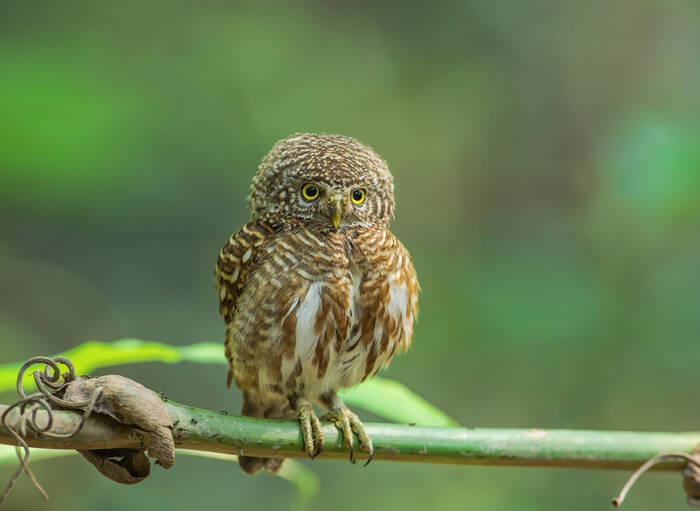Glaucidium brodiei
IUCN
LCBasic Information
Scientific classification
- name:Glaucidium brodiei
- Scientific Name:Glaucidium brodiei,Collared Owlet,Little Owl
- Outline:Raptor
- Family:Strigiformes Ostridae Owl
Vital signs
- length:14-16cm
- Weight:40-64g
- lifetime:About 10-20 years
Feature
There is an obvious light yellow collar spot on the back of the neck, and a black spot on each side.
Distribution and Habitat
Distributed in Bhutan, Brunei, Cambodia, China, India, Indonesia, Lao People's Democratic Republic, Malaysia, Myanmar, Nepal, Pakistan, Thailand, Vietnam. Origin uncertain: Bangladesh.
Distributed in Shanghai, Jiangsu, Zhejiang, Anhui, Fujian, Jiangxi, Henan, Hubei, Hunan, Guangdong, Guangxi, Hainan, Sichuan, Guizhou, Yunnan, Shaanxi, Gansu and Taiwan in China.
Inhabits mountain forests and forest edge shrubs.
Appearance
The upper body of the Collared Owl is grey-brown, covered with long and narrow light orange-yellow horizontal spots. The head is gray. The eye first and eyebrow lines are white, the ends of the eye first feathers are black whisker-like feathers, there are no ear tufts, and the facial disk is not obvious. There are fine white spots on the forehead, top of the head and sides of the head. There is a significant brown or skin-yellow collar on the back of the neck, with a black mark on each side. There are large white spots on the outer wings of the shoulder feathers, forming two significant white shoulder spots. The rest of the upper body includes the two wing coverts and the inner secondary flight feathers are dark brown with brown horizontal spots. The flight feathers are dark brown. Except for the first primary flight feather, the outer feathers all have brown-red spots, and the base of the inner feathers has white spots. The white spots become larger toward the inside, and become horiz
Details
Collared Owlet, also known as Collared Owlet, has 4 subspecies.

Collared Owlet is a solitary species except during the breeding season. It is active mainly during the day, and can also fly and forage freely in the sun at noon. When flying, it often flaps its wings sharply to make a flapping flight, and then glides for a while, alternating between the two. It is also active at dusk, and likes to sing at night, almost all night long. The singing is relatively monotonous, mostly in the form of a 4-syllable whistle, singing repeatedly. When resting, it often roosts on tall trees, and often swings its tail feathers left and right. It mainly feeds on insects and rodents, and also eats small birds and other small animals.
The collared owl is found in the northwest of the Himalayas and Assam in northern India. The breeding season is from March to July, but most of them lay eggs in April and May. It usually nests in tree holes and natural caves, and also uses the nests of woodpeckers. Each nest lays 2-6 eggs, mostly 4. The eggs are white and oval. The size is 28-31.5 mm × 23-25 mm.
Listed in the 2012 IUCN Red List of Threatened Species Ver3.1 - Least Concern (LC).
Listed as a Class II protected animal in China.
Protect wild animals and stop eating game.
Maintaining ecological balance is everyone's responsibility!








